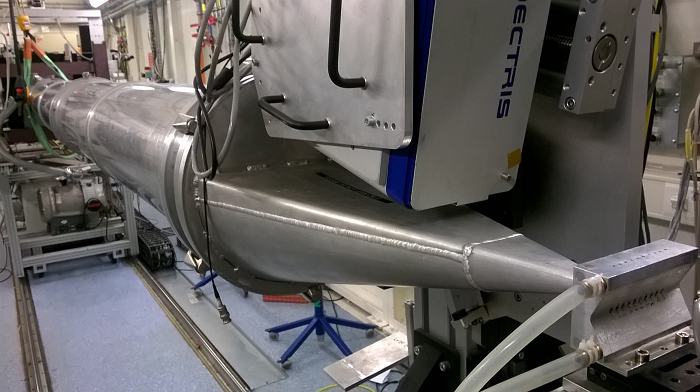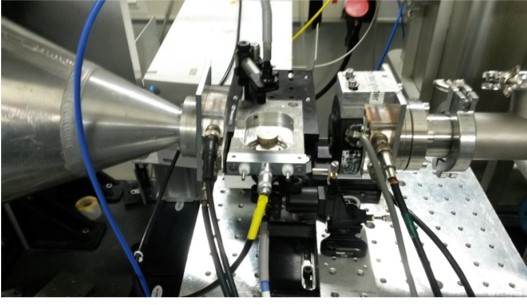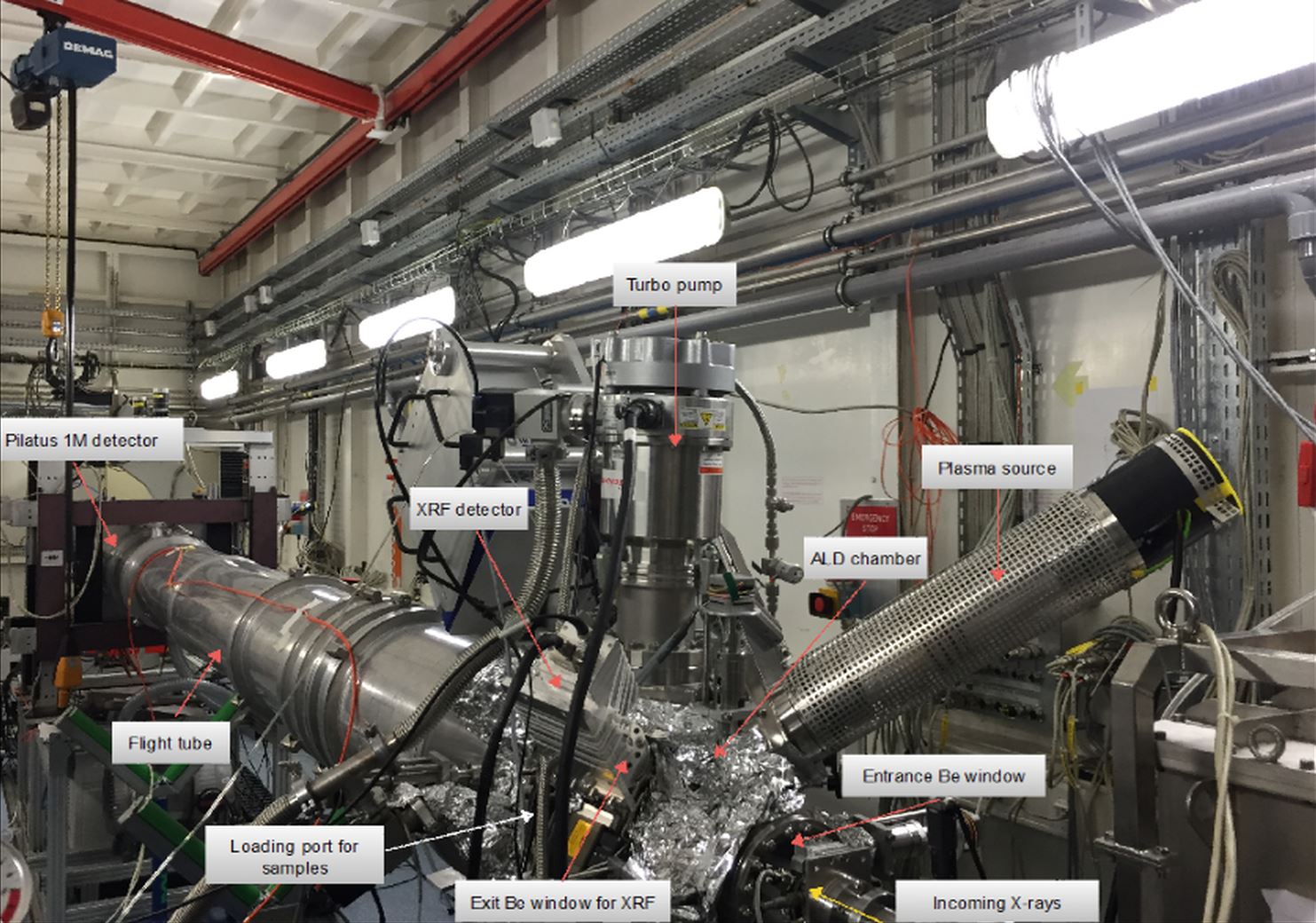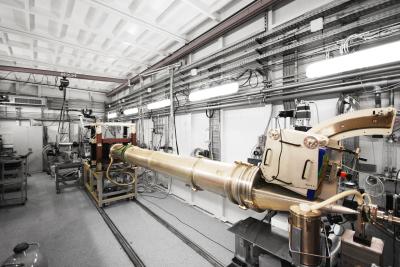BM26: SAXS/WAXS
Overview
BM26 is dedicated to SAXS/WAXS measurements. The small-angle and wide-angle patterns can be acquired simultaneously using Two Pilatus photon counting area detectors
SAXS images are collected using a Pilatus 1M detector (169mm x 179mm active area) giving a time resolution down to a few msec/frame. The minimum q-value attainable with our maximum 9.5 m sample-to-detector distance and a photon wavelength of 1.54 Å is about 0.0175 nm-1 (equivalent to a real-space d = 500 nm). The minimum SAXS detector distance is 1.3m
WAXS patterns are collected using a 300K-W linear Pilatus detector ( 254mm x 33.5mm active area). The maximum diffraction angle is about 2Ɵ = 40 °.
If required, a SAXS/WAXS setup without gap between the two measured patterns is possible for a SAXS camera length of up to 1.5 m.

SAXS/WAXS setup on BM26. The WAXS detector (300K-W) is in the foreground; SAXS (1M) detector is inside the vacuum tube 7m away
The low angle resolution of the SAXS station is dependent on the X-ray wavelength and the sample-to-detector distance.
User Guide
In these public pages you will find some information on
BM14 & BM26 common:
BM26 specific:
Wiki pages: from the intranet pages (intranet.esrf.fr) you have access to the DUBBLE Wiki pages. The Wiki contains much more technical information and details on how to set up and run your experiment on site.
Please, note that the Wiki pages are only available on site.
Click here for suppliers for rectangular glass capillaries, MICA discs ans sheets.
Spatial resolution and beam size on the sample
Post-focusing systems are available in order to achieve a smaller beam size.
GISAXS/GIWAXS
The beamline is able to perform Grazing-Incidence Small-Angle X-ray Scattering (GISAXS) and Grazing-Incidence Wide-Angle X-ray Scattering (GIWAXS) experiments, both ex-situ and in-situ, being able to accommodate diverse sample environments and multiple ancillary probes and techniques around the sample.
Sample Environment
A great variety of sample environment such as heating and cooling stages and DSC is available or can be installed on the beam line. We can also offer simultaneous SAXS/WAXS and Raman spectroscopy or simultaneous SAXS/WAXS and UV spectroscopy.
Data reduction
Data are normalised for the incident beam intensity using an in-air ionization chamber and the sample transmission is measured using a pin-diode integrated in the lead beamstop. These values are usually stored in the header of the edf or hdf5/nexus data files provided to the users.
The beamline offer the user a dedicated software for reduction of the 2-dimensional data both for SAXS and WAXS measurements. Azimuthal and radial integration are possible. This software (BUBBLE) is available at the following link:
https://soft.snbl.eu/bubble.html
Typically, a sample of AgBh, silver behenate is used for geometrical calibration (sample-to-detector distance, center of the beam, detector's rotations) of the Pilatus-1M detector employed for SAXS measurements, while a alpha-Al2O3 (alumina) sample is used for calibrating the Pilatus-300k detectoror for WAXS measurements.
Please, refer to: Dyadkin, V., Pattison, Ph., Dmitriev, V., Chernyshov, D. A new multipurpose diffractometer PILATUS@SNBL J. Synchrotron Rad., 23, 3, 2016 when using the software.
In the near future, a dedicated software for GISAX data reduction will be available too.
Links and Documentation
For a presentation of the SAXS basic theory, techniques and applications, you can download the book Small Angle X-ray Scattering (O. Glatter and O. Kratky Eds., Academic Press, 1982) from http://physchem.kfunigraz.ac.at/sm/ (Scattering Methods at the Chemistry Department, University of Graz).
For a more biologically oriented introduction one can download Structure Analysis by Small-Angle X-Ray and Neutron Scattering (L. A. Feigin and D. I. Svergun, Plenum Press / Springer, 1987) from http://www.embl-hamburg.de/biosaxs/publications.html
From a practical point of view, you might want to take a look at the Beamline Manuals page. We have posted a short Users' survival manual, the full manual for the data acquisition and reduction software for collecting and pre-processing SAXS and/or WAXS data for both static and time-resolved measurements on beamline BM26B, as well as a list of basic Unix commands.
Last but not least, the Data Reduction and Analysis page provides the response of the detector in use, together with links to data reduction and analysis software.
To estimate your sample absorption click here.
SaxsWaxs Station
If you want to know more about DUBBLE's SAXS/WAXS station, please contact Martin Rosenthal (beam line scientist).








